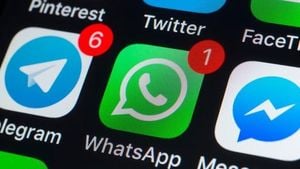Apple has officially announced its collaboration with SpaceX and T-Mobile to integrate Starlink satellite connectivity for iPhone users. This groundbreaking partnership, confirmed with the launch of iOS 18.3 on January 27, 2025, aims to revolutionize mobile communication, especially for users situated in remote areas where traditional cellular networks may falter.
The integration allows select iPhone models, particularly the iPhone 14 and newer, to send text messages using Starlink satellites when cellular service is unavailable. This feature serves as a lifeline for users venturing off the grid—whether they are hiking through mountains or traveling to rural regions. It’s all made possible with the latest software update from Apple.
With the new Starlink capability, users can take advantage of automatic connectivity, avoiding the hassle of manually aiming their devices skyward, as was previously necessary with other satellite services. Early access to this feature is limited to users who are part of the beta testing program initiated by T-Mobile.
"You’re in the T-Mobile Starlink beta. You can now stay connected with texting via satellite from virtually anywhere," many beta testers have reported receiving as part of their onboarding process. Users have begun documenting their successes, with several users confirming they could send texts from areas with no cell signal.
Elon Musk, founder of SpaceX, voiced his excitement for the initiative, stating on social media, "Medium-resolution images, music and audio podcasts should work with the current generation Starlink direct-to-phone constellation." Musk has also hinted at future upgrades, noting plans for support of medium-resolution video as part of the overall expansion of Starlink connectivity.
Apple’s new feature does not come without competition; the company had previously collaborated with Globalstar for satellite communications. The service with Globalstar required customers to point their phones to the sky to connect with satellites. With the Starlink integration, Apple aims to offer more seamless satellite connectivity, successfully leveraging low-Earth orbit satellites for broader accessibility.
Tim Cook, Apple’s CEO, expressed confidence about the partnership's potential, proclaiming, "With the cutting-edge technology of Starlink satellites combined with Apple’s innovative hardware, users will now be able to connect from anywhere around mountains, oceans, or even rural areas." This statement reflects Apple's commitment to bridging communication gaps, particularly benefiting those living or traveling far from urban centers.
The initial launch of the service emphasizes emergency communication, allowing users to send SMS messages to loved ones and emergency services even when no cellular connection is available. The feature is currently limited to text messaging, but the companies involved have ambitious plans for future updates which may integrate voice calls and data services, enhancing overall usability.
Given the rapid evolution of technology, global expansion plans are also on the horizon. Starlink co-founder Elon Musk mentioned aspirations to provide services beyond the United States. With millions still without reliable connectivity, this partnership could stretch lengths toward making communication universally accessible.
While the new Starlink connectivity brings immense promise, it also faces scrutiny from astronomers concerned about the brightness of Starlink satellites and their potential impact on astronomical observations. SpaceX has been working on measures to mitigate this effect, yet concerns remain about the integration of thousands of satellites orbiting Earth.
Overall, the launch of Starlink connectivity on iPhones marks a significant step forward for mobile technology, allowing users to communicate even when traditional networks fail. A subscription-based service will be introduced, with fees starting around $20 monthly for users wanting to access the full range of capabilities anticipated from this innovative partnership.
Apple's collaboration with SpaceX to provide Starlink satellite support stands poised to fundamentally change connectivity for many users, effectively ensuring no iPhone owner has to feel cut off, regardless of their location.



